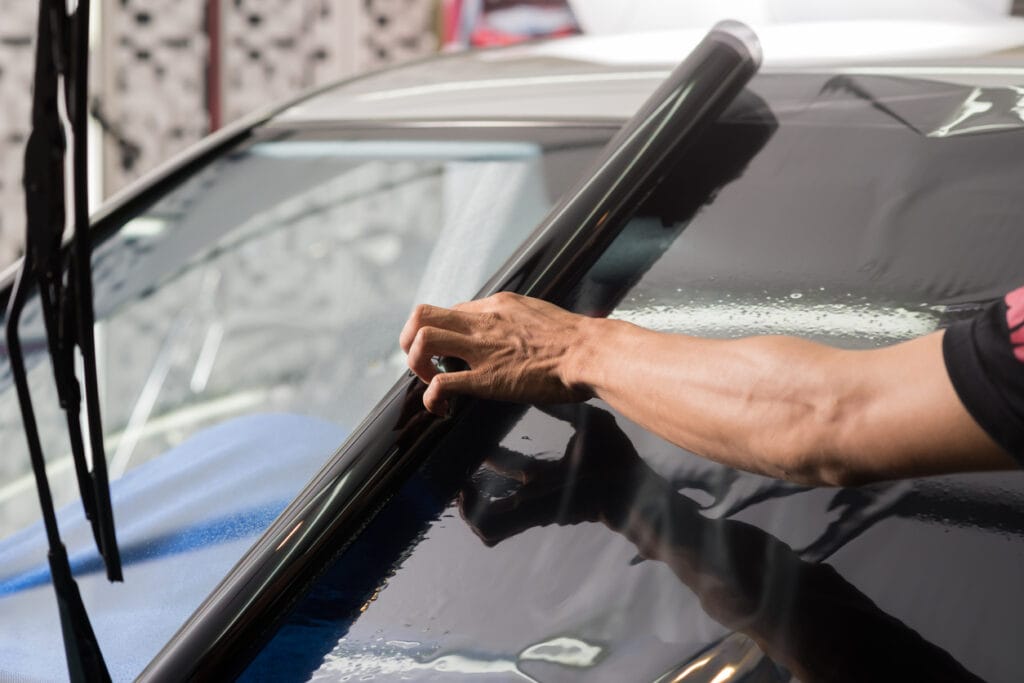Explore the essential benefits of car window tinting—UV protection, safety, comfort, and more. Learn why tinting is no longer a luxury, but a smart necessity for all drivers.

What Is Car Window Tinting?
Car window tinting is the process of applying a thin film to the interior surface of a vehicle’s windows. This film helps control sunlight penetration, improves comfort, enhances privacy, and offers protection from ultraviolet rays and glare.
Window tint comes in a variety of materials, shades, and performance levels, each designed to address different needs—from aesthetics to functionality.
Different Types of Tint Films
- Dyed Film: Budget-friendly, absorbs heat, but may fade over time.
- Metalized Film: Reflects heat using metallic particles but can interfere with GPS or radio signals.
- Carbon Film: Offers strong heat rejection and doesn’t fade; more durable than dyed.
- Ceramic Film: Premium quality, blocks UV and infrared rays, and doesn’t affect electronics.
- Hybrid Film: Combines dyed and metalized elements for balance between cost and performance.
Why Car Window Tinting Is Essential in Modern Driving
UV Ray Rejection and Skin Protection
Tinted windows block up to 99% of harmful UVA and UVB rays, protecting you and your passengers from:
- Premature skin aging
- Skin cancer risk
- Eye strain from intense sunlight
This is especially important for drivers who spend long hours on the road.
Interior Fade and Dashboard Protection
Sunlight doesn’t just affect people—it also wears down your vehicle’s interior. Leather seats, dashboards, and touchscreens can:
- Crack
- Fade
- Warp from UV exposure
Tinting keeps your interior cooler, cleaner, and newer for longer.
Heat Rejection and Cabin Comfort
Window tint can reduce interior temperatures by up to 60%, especially ceramic and carbon-based films. This leads to:
- Faster cabin cooling
- Reduced need for air conditioning
- A more comfortable driving experience in hot climates
Tinting as a Safety Feature
Shatter Resistance in Accidents
High-quality tint films add a layer of protection to your glass, helping to:
- Hold shattered glass in place during accidents
- Prevent injuries from flying shards
- Deter forced entries or break-ins
Reducing Glare from Sun and Headlights
Glare from the sun, snow, or oncoming traffic can reduce reaction time. Tinting helps minimize distractions and improves:
- Visibility
- Focus
- Overall road safety
Privacy and Theft Prevention
Tinted windows make it difficult for outsiders to see inside your vehicle, discouraging:
- Smash-and-grab theft
- Prying eyes in parking lots
- Theft of valuables like electronics and bags
Privacy tinting also adds peace of mind for families and rideshare drivers.
Energy Efficiency and Fuel Savings
By reducing heat buildup, tinting minimizes the need for constant AC use. This improves:
- Fuel economy (less strain on the engine)
- Battery life in electric vehicles
- Environmental impact through lower emissions
Legal Considerations for Window Tinting
Tinting laws vary by country and state, regulating:
- Visible Light Transmission (VLT%): The percentage of light allowed through
- Windshield tint restrictions
- Medical exemptions
- Reflectivity and color bans
Check your local regulations before choosing your tint level.
How to Choose the Right Tint for Your Car
Ask yourself:
- What’s more important—style or function?
- Do I need maximum heat rejection (ceramic)?
- Will I drive mostly in sunny or snowy areas?
- What VLT% is legal in my state?
A reputable installer can help match your goals with the right product.
Maintenance Tips for Long-Lasting Tint
- Wait 3–5 days after installation before cleaning
- Use soft microfiber cloths
- Avoid ammonia-based cleaners
- Don’t use sharp tools near window edges
Proper care extends tint life to 5–10 years or more, depending on film quality.
FAQs About Window Tinting
Q1: Does tinting affect visibility at night?
If too dark, yes. Choose legal and balanced VLT% for safe night driving.
Q2: Can I tint my windshield?
Most laws only allow the top 4–6 inches to be tinted or require medical exemptions.
Q3: Will tinting affect my vehicle’s electronics?
Only metalized films may cause interference. Ceramic and carbon are safe for GPS, Bluetooth, and radio.
Q4: How long does tint installation take?
Professional jobs typically take 1–3 hours, depending on the number of windows.
Q5: Is window tinting removable?
Yes. It can be professionally removed without damaging the glass.
Conclusion
Window tinting is not just about looks—it’s about protecting your investment, your health, and your driving experience. From blocking UV rays to preserving your interior and adding privacy, car window tinting has become a practical, affordable, and essential upgrade for modern drivers.
If you’re still thinking of tinting as a luxury—think again. It’s time to view it for what it truly is: a necessity.

